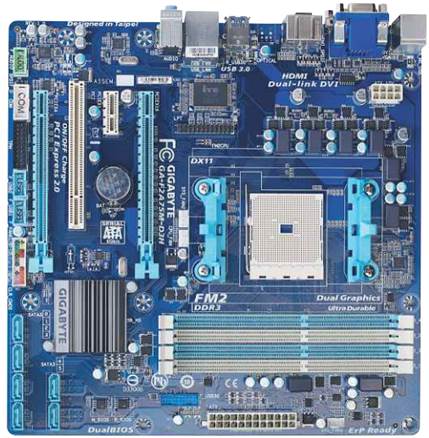Exactly what a Socket FM2 motherboard
should look like
When buying a motherboard and CPU, it’s
usually good to spend more on the CPU than the motherboard. With the A10-5800K
retailing for a little over $150, this shouldn’t be too difficult, but with
motherboards such as MSI’s A85XA-GD65 and Asus’F2A85-M Pro retailing for $129
and $164 respectively, the cost of A85X-chipset motherboards files in the face
of everything Trinity has going for it – the ability to build a cheap gamin system
that can better a similar priced Intel setup. Thankfully, Gigabyte’s F2A75M-D3H
has nailed the sweet spot.
At just $84, it’s half the price of the
Asus, meaning your motherboard and CPU combo, should you opt for the A10-5800K,
will cost around $240 instead of over $300. After all, for $300, you could pick
up an Ivy Bridge Pentium CPU, a cheap LGA1155 motherboard and a Radeon HD 7770
1GB – a far more potent gaming mix.

The micro-ATX F2A75M-D3H sports AMD’s A75
chipset, but while AMD would have you believe that only the AMD would have you
believe that only the A85X chipset allows for two discrete GPUs in CrossFireX,
the F2A75M-D3H manages this feat, too. It sports two 16x PCI-E slots, but the
downside is that the second slot is limited to just 4x, whereas the MSI offers
8x in both slots in CrossFireX mode. However, those looking to build a dual-GPU
setup would be much better off with a higher-end Ivy Bridge setup than an FM2
system anyway, so the point is moot.
The board also has single 1x PCI-E and PCI
slots for further expansion, giving you a balanced setup and plenty of options
when it comes to sound cards and TV tuner cards, especially as you can use 1x
PCI-E devices in 16x PCI-E slots too. The A75 chipset is limited to six SATA
6Gbps ports, although this will be more than enough for a typical Socket FM2
system. As with all the other boards on test, the GA-F2A75M-D3H has a plethora
of video outputs too, although it lacks DisplayPort, unlike the MSI and Asus.
Meanwhile, the layout is also generally
good. There are no heatsinks on the VRM circuitry surrounding the CPU socket,
so there’s very little to get in the way of large CPU coolers. The main PCI-E
expansion slot is also positioned so that dual or triple-slot graphics cards
won’t foul the SATA ports or USB3 header. However, use the six SATA ports. The
DIMM slots are positioned fairly close to the CPU socket too, but most Socket
FM2 coolers can be rotated; you could also use two DIMMs in dual-channel mode
in slots one and two – the furthest and third-furthest from the CPU socket –
giving you a little more breathing space.
Performance
We initially found the system crashed when
manually setting the RAM to its rated 2, 133MHz speed, but on closer
inspection, the timings were a little too tight. Setting them to the RAM’s
rated values solved the problem, but we didn’t have this timing-misdetection
issue on any other boards. Then again, the board officially doesn’t support
memory higher than 1,866MHz, so we can’t really hold that against it. At stock
speed, the F2A75M-D3H admittedly didn’t light up our performance graphs, being
the slowest board on test in many of them, but usually by less than 5 per cent.
Its overall score of 1,372 in our Media Benchmarks was slightly short of the
MSI A85XA-GD65, for example – not a deal breaker by any means.
Overclocking proved to be a surprisingly
pleasant experience with the GA-F2A75M-D3H. The EFI was excellently laid out
and rich in options, apart from the vcore adjustment lacking an absolute
voltage mode. Our A10-5800K test chip quickly rose to 4.5GHz after setting the
vcore to 1.5V and disabling Cool ‘n’ Quiet and C6 State options. However,
increasing this to 4.6GHz with a 1.55V vcore saw temperatures rise to toasty
levels and resulted in an unstable system. We also managed to increase the GPU
core frequency to 1GHz from 800MHz. The board was able to recover brilliantly
from failed overclocks too, which the ASRock FM2A75 Pro 4 and Asus F2A85-M Pro
failed to manage on occasions.

Gigabyte’s
F2A75M-D3H has nailed the sweet spot
The increase in CPU speed saw the overall
Media Benchmarks suite score rise over 100 points to 1,476, while this and the
increase in GPU frequency resulted in the minimum frame rate in Skyrim leaping
from 26fps to 29fps. Adding a GeForce GTX 680 2GB to the system for the Crysis
2 test didn’t see a great benefit from the rather tame overclock we managed to
achieve on the A10-5800K APU, but this was the same on all our motherboards.
The overclock also saw over 60W added to the load system power draw – this is
worth bearing in mind if you intend to keep power consumption to a minimum.
Conclusion
Despite slightly slower results than some
of the other boards, the bargain tastic GA-F2A75M-D3H was never far behind and
managed to overclock our A10-5800K APU as far as the rest of the pack too.
Combined with lots of expansion options, and an exceptionally low price
compared to the A85X boards on test, it’s difficult not to recommend
unequivocally. It also has the edge on the ASRock FM2A75 Pro 4 with its
superior EFI and excellent overclock recovery system. It’s the perfect choice
for a budget Socket FM2 gaming system.
|
Details
Gigabyte – Cheap; great EFI; good overclocker
Love bite – Basic feature set; slightly
slower performance than A85X boards
Product code: GA-F2A75M-D3H
Price: $84
Manufacturer: http://www.gigabyte.com
|